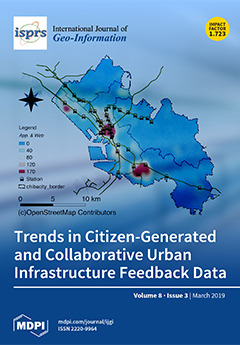The effectiveness of disaster response depends on the
correctness and
timeliness of data regarding the location and the impact of the event. These two issues are critical when the data come from citizens’ tweets, since the automatic classification of disaster-related tweets suffers from
[...] Read more.
The effectiveness of disaster response depends on the
correctness and
timeliness of data regarding the location and the impact of the event. These two issues are critical when the data come from citizens’ tweets, since the automatic classification of disaster-related tweets suffers from many shortcomings. In this paper, we explore an approach based on
participatory sensing (i.e., a subset of mobile crowdsourcing that emphasizes the active and intentional participation of citizens to collect data from the place where they live or work). We operate with the hypothesis of a “
friendly world”, that is by assuming that after a calamitous event, in the survivors prevails the feeling of helping those who suffer. The extraction, from the Twitter repository, of the few tweets relevant to the event of interest has a long processing time. With the aggravating circumstance in the phase that follows a severe earthquake, the elaboration of tweets clashes with the need to act promptly. Our proposal allows a huge reduction of the
processing time. This goal is reached by introducing a
service and a
mobile app, the latter is an intermediate tool between Twitter and the citizens, suitable to assist them to write structured messages that act as surrogates of tweets. The article describes the
architecture of the software service and the
steps involved in the retrieval, from the Twitter server, of the messages coming from citizens living in the places hit by the earthquake; moreover, it details the storage of those messages into a geographical database and their processing using SQL.
Full article





